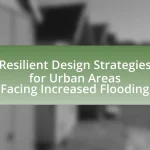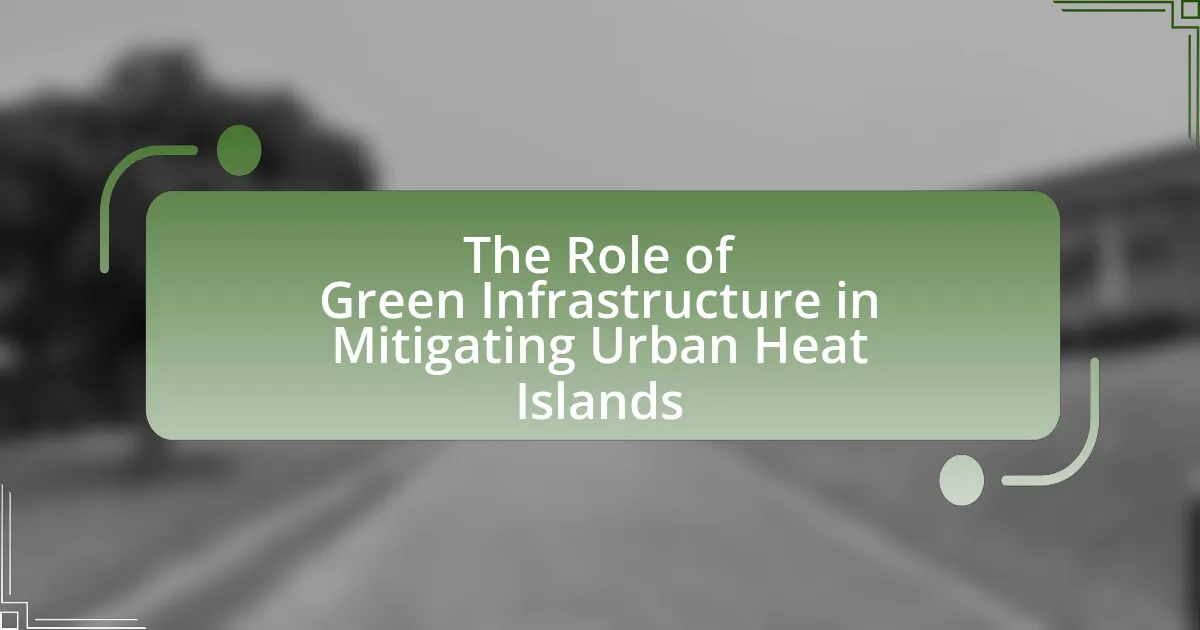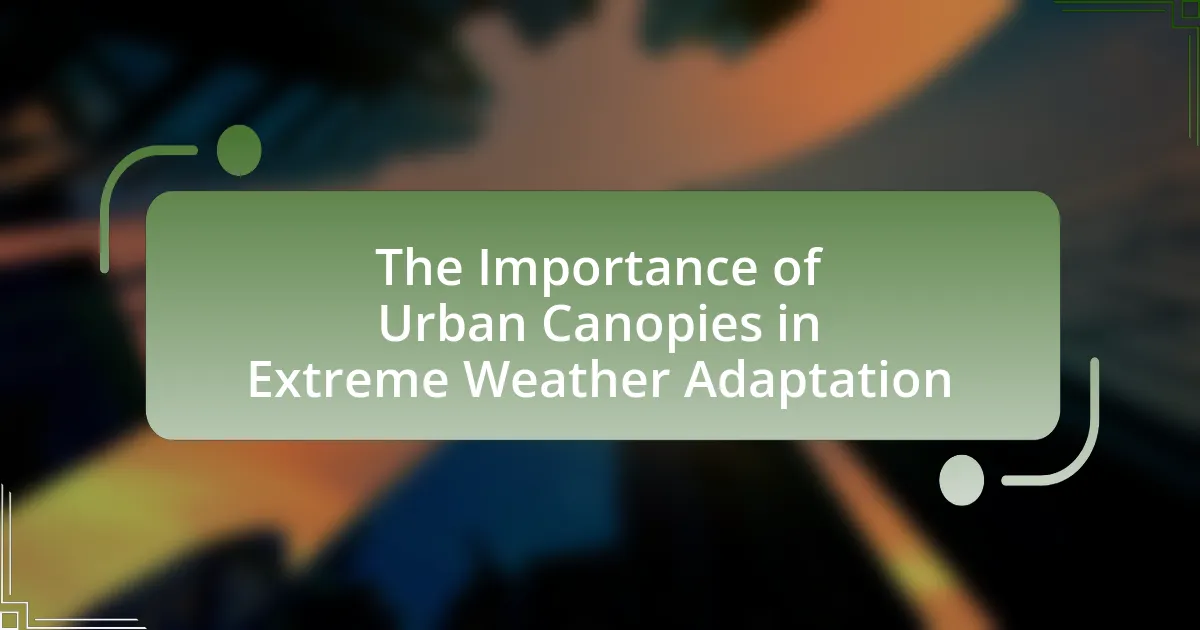The article focuses on the critical topic of designing for drought within urban planning, emphasizing various water conservation techniques essential for sustainable urban environments. Key principles discussed include water-efficient landscaping, sustainable water management systems, and the integration of green infrastructure, which collectively aim to reduce water consumption and enhance drought resilience. The article also explores the impact of urban density on water usage, the environmental consequences of urban water consumption, and the role of community engagement in promoting effective water conservation strategies. Specific techniques such as rainwater harvesting, xeriscaping, and the use of permeable pavements are highlighted as practical solutions for urban planners to implement in order to mitigate the effects of drought and ensure sustainable water management.
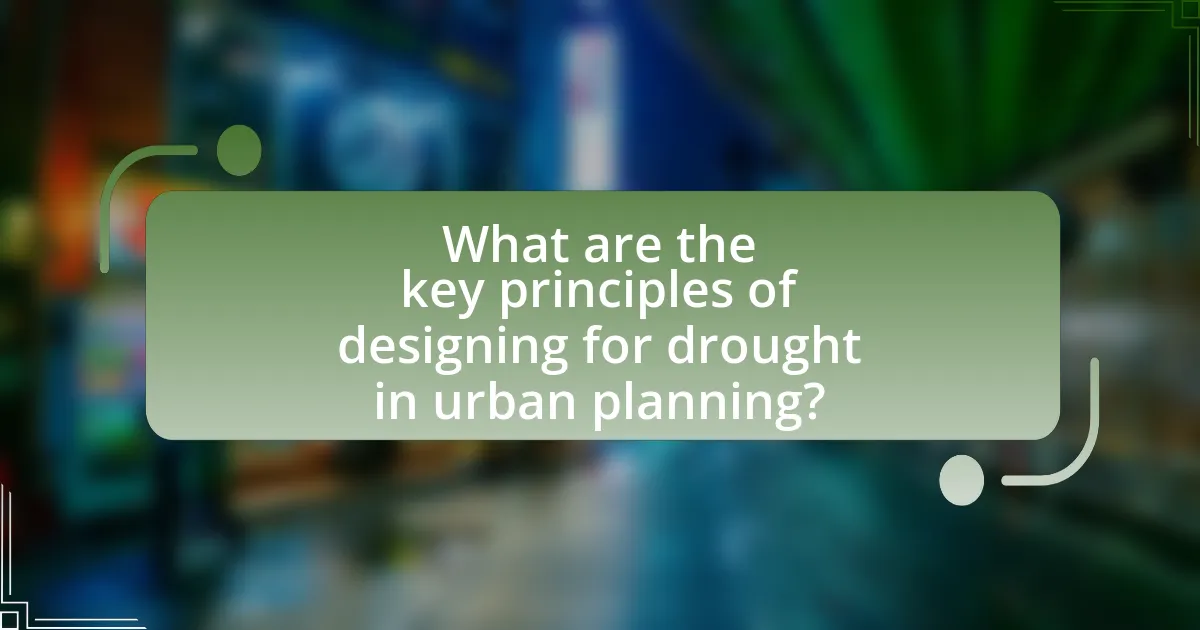
What are the key principles of designing for drought in urban planning?
The key principles of designing for drought in urban planning include water-efficient landscaping, sustainable water management systems, and the integration of green infrastructure. Water-efficient landscaping utilizes native and drought-resistant plants to minimize irrigation needs, thereby conserving water resources. Sustainable water management systems, such as rainwater harvesting and greywater recycling, help to reduce reliance on potable water sources. The integration of green infrastructure, including permeable pavements and green roofs, enhances stormwater management and promotes groundwater recharge. These principles are supported by studies indicating that urban areas implementing such strategies can reduce water consumption by up to 30%, demonstrating their effectiveness in drought resilience.
How does urban planning impact water conservation efforts?
Urban planning significantly impacts water conservation efforts by integrating sustainable practices that optimize water use and management. Effective urban planning incorporates green infrastructure, such as permeable pavements and rain gardens, which enhance groundwater recharge and reduce runoff. For instance, cities that implement these strategies can decrease stormwater runoff by up to 90%, as demonstrated in studies conducted by the U.S. Environmental Protection Agency. Additionally, zoning regulations that promote high-density development can reduce the overall water footprint by minimizing land consumption and preserving natural water systems. Therefore, urban planning plays a crucial role in shaping water conservation strategies that lead to more resilient and sustainable urban environments.
What role does landscape design play in water conservation?
Landscape design plays a crucial role in water conservation by implementing strategies that reduce water usage and enhance the natural water cycle. Effective landscape design incorporates native plants, xeriscaping, and efficient irrigation systems, which collectively minimize the need for supplemental watering. For instance, using drought-resistant plants can reduce landscape water consumption by up to 50%, as these plants are adapted to local climate conditions and require less water. Additionally, landscape designs that include rain gardens and permeable surfaces help capture and manage stormwater, allowing it to infiltrate the ground rather than run off, thus replenishing groundwater supplies. These practices not only conserve water but also promote sustainable urban ecosystems.
How can urban density influence water usage?
Urban density significantly influences water usage by increasing demand due to concentrated populations and infrastructure. Higher urban density often leads to greater impervious surfaces, which can reduce groundwater recharge and increase runoff, thereby straining water supply systems. For instance, cities with high density typically require more water for residential, commercial, and industrial purposes, leading to higher overall consumption rates. According to the U.S. Environmental Protection Agency, urban areas can use up to 50% more water per capita than rural areas due to these factors. This relationship highlights the need for efficient water management strategies in densely populated regions to mitigate the impact on water resources.
Why is water conservation critical in urban environments?
Water conservation is critical in urban environments due to the increasing demand for water resources amidst growing populations and climate change. Urban areas often face water scarcity, which can lead to higher costs for water supply and increased pressure on local ecosystems. For instance, according to the U.S. Environmental Protection Agency, urban areas account for approximately 80% of the nation’s water use, highlighting the need for effective conservation strategies to ensure sustainable water management. Additionally, conserving water helps reduce the energy required for water treatment and distribution, further mitigating environmental impacts.
What are the environmental impacts of urban water consumption?
Urban water consumption significantly impacts the environment by depleting local water resources, altering natural ecosystems, and contributing to pollution. The extraction of water from rivers, lakes, and aquifers can lead to reduced water levels, affecting aquatic habitats and biodiversity. For instance, over-extraction from the Colorado River has resulted in diminished flow, impacting species such as the endangered humpback chub. Additionally, urban runoff from water usage often carries pollutants into waterways, leading to water quality degradation. According to the U.S. Environmental Protection Agency, urban runoff is a leading cause of water pollution in the United States, affecting both human health and aquatic life. Furthermore, the energy required for water treatment and distribution contributes to greenhouse gas emissions, exacerbating climate change. Thus, urban water consumption has multifaceted environmental consequences that necessitate effective water conservation strategies in urban planning.
How does climate change affect urban water resources?
Climate change significantly impacts urban water resources by altering precipitation patterns and increasing evaporation rates. These changes lead to more frequent and severe droughts, which reduce the availability of freshwater supplies in urban areas. For instance, studies indicate that many regions are experiencing a decline in annual rainfall, with some areas reporting reductions of up to 20% over the past few decades. Additionally, higher temperatures can increase evaporation from reservoirs and soil, further diminishing water availability. This combination of reduced precipitation and increased evaporation stresses urban water systems, necessitating the implementation of effective water conservation techniques in urban planning to ensure sustainable water management.
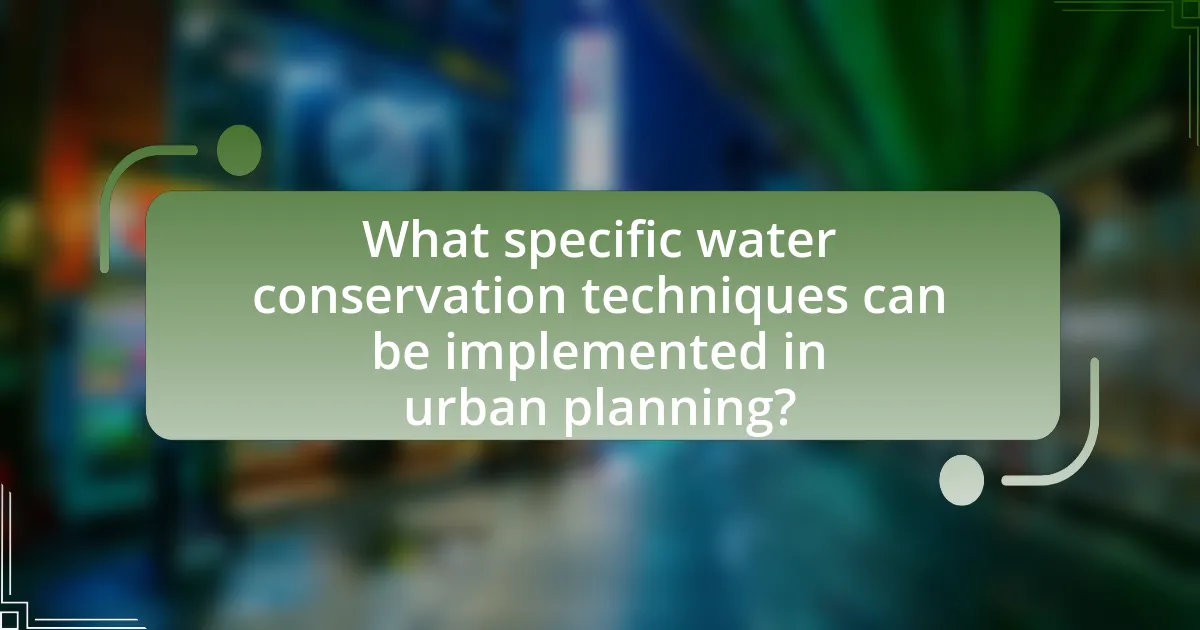
What specific water conservation techniques can be implemented in urban planning?
Specific water conservation techniques that can be implemented in urban planning include rainwater harvesting, xeriscaping, and the use of permeable pavements. Rainwater harvesting systems capture and store rainwater for irrigation and non-potable uses, reducing reliance on municipal water supplies. Xeriscaping involves designing landscapes that require minimal irrigation by using drought-resistant plants, which can significantly lower water consumption. Permeable pavements allow rainwater to infiltrate the ground, reducing runoff and promoting groundwater recharge. These techniques are supported by studies indicating that urban areas can reduce water usage by up to 50% through effective implementation of such strategies.
How can rainwater harvesting systems be integrated into urban designs?
Rainwater harvesting systems can be integrated into urban designs by incorporating collection and storage infrastructure within building designs, public spaces, and green areas. For instance, rooftops can be equipped with gutters and downspouts that direct rainwater into storage tanks, while permeable pavements in parking lots and walkways can facilitate groundwater recharge. Additionally, urban planners can design bioswales and rain gardens that not only manage stormwater but also enhance aesthetics and biodiversity. Studies indicate that cities implementing rainwater harvesting can reduce stormwater runoff by up to 50%, thereby mitigating flooding and conserving potable water resources.
What are the benefits of using rainwater harvesting in cities?
Rainwater harvesting in cities provides multiple benefits, including reduced demand on municipal water supplies, improved stormwater management, and enhanced water quality. By capturing and utilizing rainwater, cities can decrease their reliance on treated drinking water for non-potable uses, such as irrigation and toilet flushing, which can lead to significant water savings. For instance, studies indicate that rainwater harvesting can reduce urban water consumption by up to 50%. Additionally, this practice helps mitigate flooding and erosion by controlling runoff, thereby protecting urban infrastructure. Furthermore, rainwater is typically free from the contaminants found in stormwater runoff, leading to improved water quality when used for irrigation. These benefits collectively contribute to more sustainable urban water management practices.
What challenges exist in implementing rainwater harvesting systems?
Implementing rainwater harvesting systems faces several challenges, including high initial costs, regulatory hurdles, and public perception issues. High initial costs can deter homeowners and municipalities from investing in these systems, as installation and maintenance require significant financial resources. Regulatory hurdles often arise from local building codes and zoning laws that may not accommodate rainwater harvesting, complicating the approval process. Additionally, public perception issues, such as misconceptions about water quality and safety, can hinder community acceptance and participation in rainwater harvesting initiatives. These challenges collectively impact the widespread adoption of rainwater harvesting systems in urban planning for drought resilience.
What role do green roofs and permeable pavements play in water conservation?
Green roofs and permeable pavements significantly contribute to water conservation by reducing stormwater runoff and enhancing water infiltration. Green roofs absorb rainwater, which minimizes the volume of water that enters drainage systems, thereby decreasing the risk of flooding and erosion. Studies indicate that green roofs can retain up to 75% of rainfall, depending on the design and vegetation used. Permeable pavements allow water to pass through their surface, facilitating groundwater recharge and reducing surface runoff. Research shows that permeable pavements can reduce runoff by 50% to 100%, depending on the rainfall intensity and pavement design. Together, these technologies promote sustainable urban water management and mitigate the impacts of urbanization on natural water cycles.
How do green roofs contribute to urban water management?
Green roofs contribute to urban water management by absorbing rainwater, reducing runoff, and improving water quality. These systems can retain up to 80% of precipitation during rain events, which mitigates flooding and decreases the burden on stormwater systems. Additionally, the vegetation and soil layers filter pollutants from rainwater, enhancing the quality of water that eventually reaches drainage systems. Studies have shown that green roofs can significantly lower peak runoff rates, making them an effective tool for sustainable urban water management.
What are the advantages of permeable pavements in reducing runoff?
Permeable pavements significantly reduce runoff by allowing water to infiltrate through their surface, thereby decreasing surface water accumulation. This infiltration process helps recharge groundwater supplies and minimizes the risk of flooding during heavy rainfall events. Studies indicate that permeable pavements can reduce runoff by up to 50% compared to traditional impermeable surfaces, effectively managing stormwater and enhancing water quality by filtering pollutants.
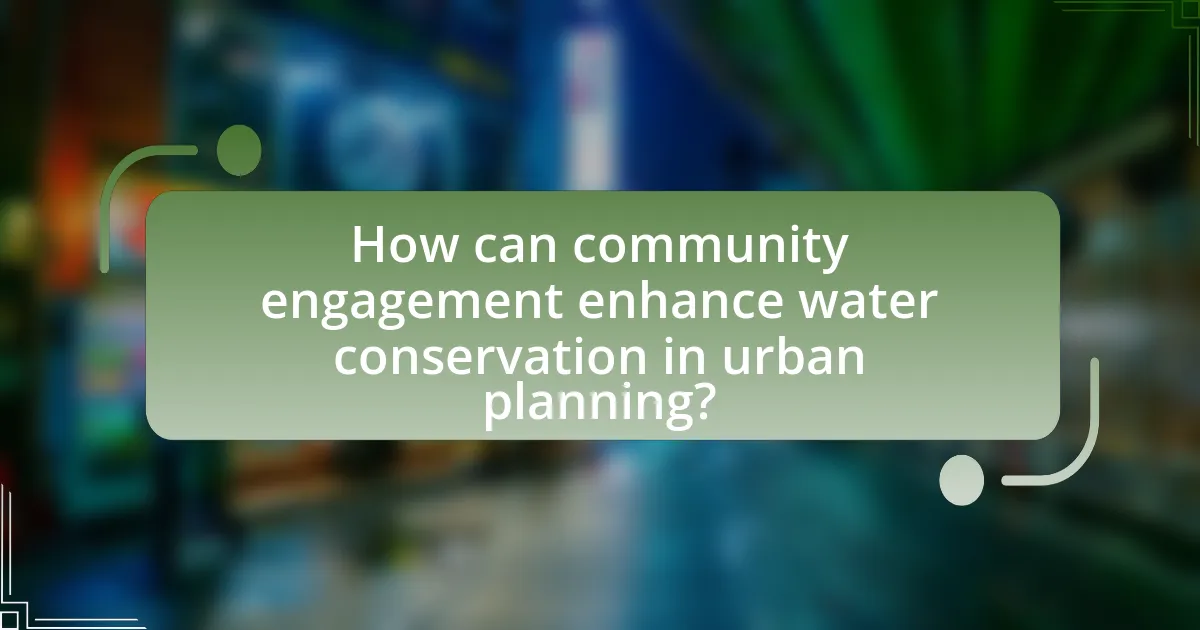
How can community engagement enhance water conservation in urban planning?
Community engagement enhances water conservation in urban planning by fostering collaboration between residents, planners, and policymakers, leading to more effective and sustainable water management strategies. Engaged communities are more likely to participate in water conservation initiatives, such as rainwater harvesting and xeriscaping, which have been shown to reduce water usage by up to 50% in some urban areas. Furthermore, studies indicate that when residents are involved in the planning process, they contribute valuable local knowledge and preferences, resulting in tailored solutions that address specific water conservation needs. For example, the City of San Diego’s community-driven water conservation programs have led to a 20% reduction in per capita water use since their implementation, demonstrating the tangible benefits of active community participation in urban planning.
What strategies can be used to involve the community in water conservation efforts?
Community engagement in water conservation efforts can be effectively achieved through educational programs, participatory initiatives, and incentive-based strategies. Educational programs, such as workshops and school curricula, raise awareness about water scarcity and conservation techniques, leading to informed community members. Participatory initiatives, like community clean-up events and local water audits, encourage residents to take an active role in monitoring and improving water use in their neighborhoods. Incentive-based strategies, such as rebates for water-efficient appliances or rainwater harvesting systems, motivate individuals to adopt sustainable practices. These approaches have been shown to increase community involvement and promote long-term water conservation behaviors, as evidenced by successful programs in cities like San Diego, which reported a 20% reduction in water use through community engagement initiatives.
How can educational programs promote sustainable water practices?
Educational programs can promote sustainable water practices by integrating water conservation education into curricula and community outreach initiatives. These programs can teach individuals about the importance of water conservation, the impact of water scarcity, and practical techniques for reducing water usage, such as rainwater harvesting and xeriscaping. Research indicates that educational interventions can lead to significant behavioral changes; for instance, a study published in the Journal of Environmental Education found that participants who engaged in water conservation education reduced their water consumption by an average of 20%. By equipping individuals with knowledge and skills, educational programs foster a culture of sustainability and empower communities to implement effective water-saving measures.
What role do local governments play in fostering community involvement?
Local governments play a crucial role in fostering community involvement by facilitating public engagement in decision-making processes. They achieve this through initiatives such as public forums, community workshops, and participatory budgeting, which encourage residents to voice their opinions and contribute to local policies. For instance, a study by the International City/County Management Association found that communities with active local government engagement programs saw a 30% increase in citizen participation in local governance. This demonstrates that local governments not only provide platforms for community input but also enhance civic responsibility and collaboration among residents, ultimately leading to more effective urban planning and resource management, particularly in areas like water conservation during drought conditions.
What are the best practices for implementing water conservation techniques in urban areas?
The best practices for implementing water conservation techniques in urban areas include the installation of efficient irrigation systems, the use of drought-resistant landscaping, and the promotion of rainwater harvesting. Efficient irrigation systems, such as drip irrigation, reduce water waste by delivering water directly to plant roots, which can save up to 50% more water compared to traditional methods. Drought-resistant landscaping, often referred to as xeriscaping, utilizes native plants that require less water, thereby minimizing irrigation needs. Rainwater harvesting systems capture and store rainwater for later use, which can significantly reduce reliance on municipal water supplies. According to the American Society of Landscape Architects, these practices not only conserve water but also enhance urban resilience to climate change impacts.
How can cities measure the effectiveness of their water conservation strategies?
Cities can measure the effectiveness of their water conservation strategies by analyzing water usage data before and after the implementation of these strategies. This involves tracking metrics such as total water consumption, per capita water use, and changes in demand during drought conditions. For instance, a study by the American Water Works Association found that cities implementing specific conservation measures, like tiered pricing and public awareness campaigns, saw reductions in water use by up to 20%. Additionally, cities can conduct surveys to assess public engagement and behavior changes regarding water use, further validating the impact of their conservation efforts.
What common pitfalls should urban planners avoid when designing for drought?
Urban planners should avoid the pitfall of underestimating the importance of native vegetation in drought-resistant landscaping. Incorporating native plants reduces water consumption significantly, as these species are adapted to local climate conditions and require less irrigation. Additionally, planners must not overlook the integration of permeable surfaces in urban design; these surfaces allow rainwater to infiltrate the ground, replenishing aquifers and reducing runoff. Failing to implement efficient irrigation systems is another critical mistake; planners should prioritize drip irrigation and smart technology to optimize water use. Lastly, neglecting community engagement can lead to designs that do not meet the needs of residents, resulting in ineffective drought management strategies.
What practical tips can urban planners follow to enhance water conservation?
Urban planners can enhance water conservation by implementing green infrastructure, such as rain gardens and permeable pavements, which facilitate natural water absorption and reduce runoff. These techniques not only help manage stormwater but also recharge groundwater supplies. For instance, a study by the U.S. Environmental Protection Agency found that green infrastructure can reduce urban runoff by 30-50%, significantly contributing to water conservation efforts. Additionally, planners should promote the use of native landscaping, which requires less irrigation and is better adapted to local climate conditions. By integrating these strategies into urban design, planners can effectively contribute to sustainable water management.


